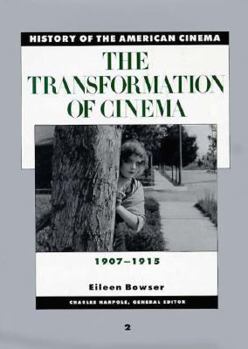History of the American Cinema: The Transformation of Cinema, 1907-1915
(Book #2 in the History of the American Cinema Series)
Select Format
Select Condition 
Book Overview
Eileen Bowser chronicles the history of the American film business from the days of storefront nickelodeons to the premiere of D. W. Griffith's The Birth of a Nation. The effect of the... This description may be from another edition of this product.
Format:Hardcover
Language:English
ISBN:0684184141
ISBN13:9780684184142
Release Date:December 1990
Publisher:Charles Scribner's Sons
Length:352 Pages
Weight:2.60 lbs.
Dimensions:1.3" x 7.4" x 10.3"
Customer Reviews
3 ratings
An excellent study of the development of early cinema
Published by Thriftbooks.com User , 18 years ago
As a silent film enthusiast I thoroughly enjoyed reading "The Transformation of Cinema" and got a lot out of it. Although the author takes quite a scholarly approach (with extensive notes and bibliography), I found the book to be fairly easy reading throughout, and each chapter, which deals with a separate theme and includes good photos, is just the right length. This book is probably best for the more serious student or enthusiast of early film development, rather than for general reading or information on certain films or people. The author's approach is an overall one, encompassing the mentality and social conditions of the time in the US which influenced the development of cinema, such as, for example, the attitude in the early years that moving pictures were only for the `great unwashed masses' and was looked down upon by middle and upper classes. As a result, influential people concerned with `uplift' in society pushed to make films educational, intelligent and appealing to the more intellectual classes of society. Then there was a backlash as the majority of people preferred to be entertained rather than lectured, and further chapters focus on the changes that took place in filmmaking: moving cameras, lighting, editing, fade-outs and so on. Many films are mentioned as examples, but there is no section devoted to any person or film in particular. Instead, the author takes an all-encompassing approach which shows how people responded to moving pictures in the first place, then how producers and filmmakers responded to the public's reactions, tried to influence the public in various ways, and how all these interactions led to the transformation of nickelodeons into cinemas as we know them today. I found this to be a very good, informative and enlightening approach which was handled well, making this book an important foundation in the understanding and appreciation of moving pictures.
Thorough examination of American Film History from 1907-1915
Published by Thriftbooks.com User , 21 years ago
Ms. Bowser has written a detailed history of this film period, using her extensive research from early film trade magazines and the court records for the Patent War trial proceedings. The Patent litigation can be very confusing, but she does a good job of pointing out the important highlights. Besides the Patent War, the Patents Company also lost the economic war with the independent film producers and distributors. She describes the rise of the nickelodeon theatres, and the backlash against films by some moral "authorities" of the time. She shows many examples of films where the camera creeped closer to the actors than just a full shot of their body, and the early attempts to tell a story better by editing different shots together. This period was the very beginning of the "star" system. Many studios resisted releasing the names of their actors, but others (including a few licensed producers) were happy to do so. With the coming of feature films came bigger, more elaborate movie palaces. And although Hollywood started booming in this period, films were being made in New York City, New Jersey, Florida, San Antonio, Chicago, Ireland, Cuba, and many other places.Because this book convers only American films, the reader will miss out on film history being made in Europe and the rest of the world. However, it does explain how Italian spectacles in 1913-1914 influenced certain American filmmakers. And Pathe Freres in France had some influence over distribution patterns in the USA before World War I. The main reason that I didn't give this book 5 stars is that it only describes major films as to their editing techniques or social content. There is no analysis as a whole of major films like THE ITALIAN, MUSKETEERS OF PIG ALLEY and others. Also, short comedies like the Mack Sennett Keystones only have a couple of pages, and Charlie Chaplin (who started working in 1914) and Sidney Drew barely have a mention.
transformation of cinema! Great read!
Published by Thriftbooks.com User , 23 years ago
the University of California seriers on American Cinema is truely a wonderful collection on the movies. "Transformation..." gives a pretty detailed account of the changes in exhibition and production as well as the presentation of films to the public during the nickelodean phase. It debunks some myths concerning this period concerning Hollywood versus New York and New Jersey, the invention of the star system, the role of the director in production, etc. It also give a lot of detail on the changes in distribution during this period. A bargain for any film buff.





